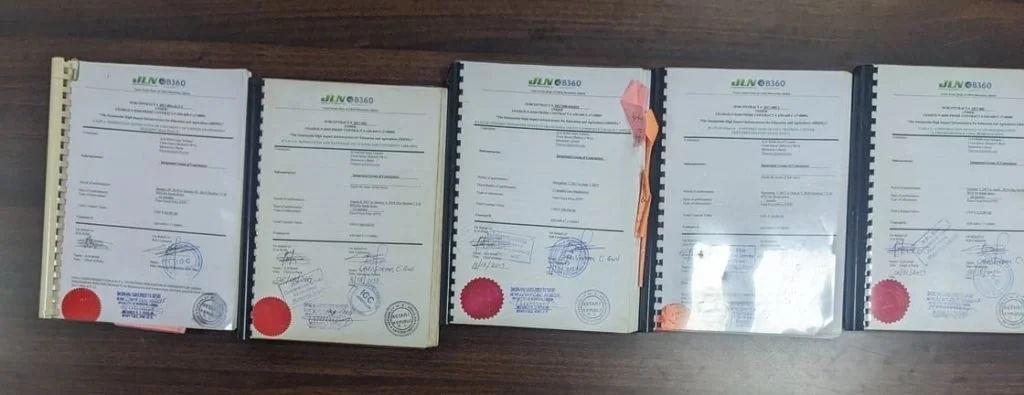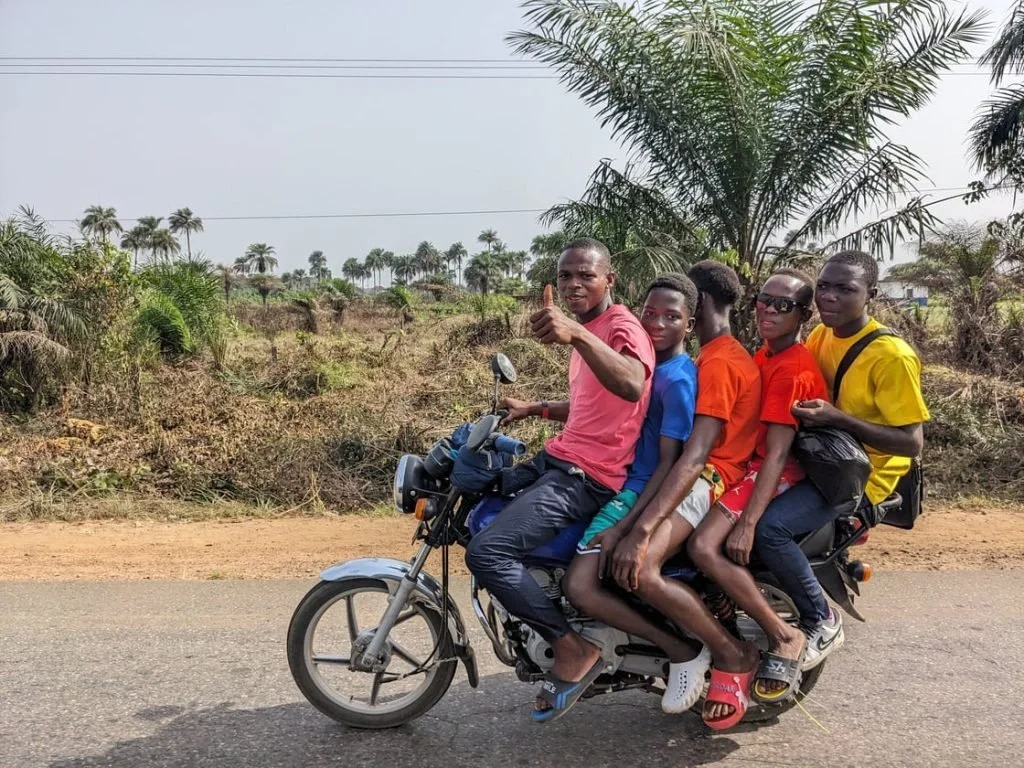2025 Trip to Liberia Travel Log – Day 7
"IT'S All ABOUT THE FOOD" is what Pastor Sylvester said again this morning. "The Light of the World Academy has wonderful facilities, dedicated staff and a joyful culture, but a hungry child cannot learn, and cannot be joyful. The MannaPack Meals from Feed My Starving Children are delicious AND nutritious. In the photo above are the cooks delivering the meals to the senior classroom. You can see the students in the doorway ready to receive it. Meals are delivered and served in the classrooms during the day. This approach is less disruptive to the school day. Now for a Where's Waldo moment, can you find Jeff & Chris in the photo?
I wished I could have seen where and how meals for nearly 400 students are prepared! They start early and typically cook over a charcoal or wood fire.
Owen, our driver and tour guide for the week, introduced us to his brother Chris, a civil engineer, who owns a construction business. His company will build single family homes, church buildings and have even built a beach resort with pool, tennis courts and hotel. We talked about the parsonage for Pastor Sylvester, the partially built recreation center at My Brother's Keeper orphanage, and also about another possible project: how one goes about planning and constructing a neighborhood park.
We had asked several people during our visit if the changes in US policy regarding USAID was affecting them - and most said it was not having a direct effect so far. In my travels in business it has always been interesting how the people around the world are aware of current events in the US and also our history. Today, we were getting schooled by Chris about how USAID works from the guy that has signed contracts and completed projects for USAID. There are many separate parts of USAID. This 'branch' would be considered "development". A different 'branch provides food aid (primarily by purchasing grain from U.S. farmers) and another runs a large AIDS program.
This branch of USAID gets projects done by providing grants to US-based companies (with a few employees in Liberia) that then use contractors (like Chris' company) to execute the grant (for example, build a school). The Liberian government is NOT involved in these grants. Government corruption in Liberia is rampant. For example, several years ago an entire shipping container of bank notes (paper currency) went missing…and has not been found. That is bold! What would you do with a container of cash?
Chris described a grant to build 20 WASH stations (water, sanitation, and hygiene) in rural areas. The grant includes hardware (a deep well, a building with flush toilets and sinks to wash hands, and a septic field). The grant also includes training about sanitation and equipment maintenance.
The 20 Wash Stations were to be built by 4 or 5 different contractors and the sanitation and maintenance training was provided by a different organization. The actual contracts Chris showed us (pictured above) include upgrade of university buildings at the University ($299,000) and clearing a site for a training center ($19,000). As a comparison, in 2023, the University of Minnesota broke ground on a new Chemistry building expected to cost $144 million. So, in the contracting world, the contracts Chris are not huge. From Chris' standpoint, this system is working well. The bids for the work are competitive and the results are monitored. It is a structure that prevents money getting gobbled up by the corrupt Liberian government while still providing needed infrastructure to Liberians. What is not clear is the amount of overhead involved. For example for that $299,000 contract, how much additional did it cost the U.S. taxpayer? Was it more than 10%? Yes, probably. Was it more than 1,000%? No, hopefully not. This is one reason the name "beltway bandits" was coined. How much are the consulting companies around the Washington D.C. beltway getting paid to write and administer grants? If it is 1,000%, that would sound like corruption to me. But I don't know what the number is. I do know that the U.S. spends less than 1% of its budget on foreign assistance and we do a LOT of good with it. Is it grandstanding to cut programs that fund AIDS clinics, provide food (that U.S. farmers get paid for), and development projects that benefit most of the population Especially when the total amount of foreign assistance is less than 1% of the total federal budget.
We attended the noon meeting of The Rotary Club of Monrovia (RCM) where I was asked to be the speaker. There were about 15 people in the room and another 15 online. The RCM is the host club for the Global Grant, "Ear & Hearing Care for Liberia" that I am working on. Just before the meeting started the power went off in the building. I started presentation with only my laptop in the middle of the conference room table and switched to the large screen when the power was restored.
In the "its a small world department", I met Peggy (she is in green top in the photo). She was also a visitor to the meeting. Her organization, TeamWork Africa, is supporting a school in Liberia and is a likely collaborator for us. She lives in Eau Claire, Wisconsin. At the hotel we met a couple from North Dakota that was starting a farm and school a few miles from My Brothers Keeper, the orphanage we visited earlier in the week. We passed along Ralph's contact information.
Connections, connections everywhere!
You may have heard of a "Bicycle Built for Two", but how about a motorcycle built(?) for Five? This picture was taken on the road to the airport. It was like a parting gift from Liberia - people with a "can-do attitude".
Jeff and I will be traveling for 24 hours before reaching home. There will be one more entry in the travel log after this one. Your comments and feedback have been motivating.
Thank you.





